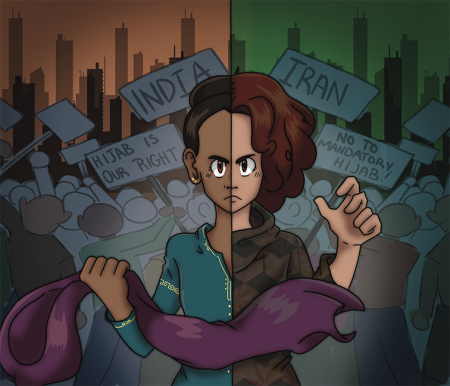
Living in the U.S., we can sometimes forget the struggles people in other countries go through to gain basic human rights.
Recently, protests in Iran to end modesty laws have gained traction on social media, particularly on TikTok. The protests began after the death of Mahsa Amani, who was arrested for allegedly breaking the modesty laws around wearing a hijab and taken into custody by the morality police.
Amani’s family, as well as many other people in the country, believe she was tortured and killed by the authorities.
Her death sparked protests all over the country with women demanding the right to dress as they please, going as far as even burning their hijabs in the streets.
Iran’s government has responded brutally to these protests, and many people have been injured and even killed.
While women in Iran are fighting for their right to remove the hijab, the women in India are fighting for their right to keep it.
India’s government has made it very clear that its dislike of Muslims outweighs the care it may have for its own people. The discrimination Muslims face on a day-to-day basis is one thing, but now women and girls are being denied entry to work and school if they choose to wear a hijab.
Similar to the Iranian protests, many Indians — Muslims and non-Muslims alike — were outraged by this, which began another set of protests.
Although these women seem to have opposite causes, their main goal is the same. They each want the right to live their lives and dress the way they want.
The U.S. is a country that has the concept of division between church and state, and it’s easy to forget the choices that are in the hands of the people because of it. It is a luxury that not many get to experience.
For women in countries like Iran and India, the political influence and twisted religious laws created by their governments have an effect on every aspect of their lives.
Many have questioned what the reasoning behind the government’s interest in the non-issue of how women choose to dress is really about.
There are hundreds if not thousands of other issues that should be the focus of government officials, and yet they choose to go after a piece of clothing. Why? Control. The answer always seems to be a need for control over women.
It’s as if they believe that not allowing a hijab, or on the other end forcing it on, will somehow break the spirit of these women into submission. But the courage of these women and the men who come out to support them just goes to show how wrong that belief system is.
The term “live and let live” cannot be a mantra for these government officials because one side of this issue refuses to give religious freedom by stripping it away completely and the other creates random rules that make no sense and slaps a religious label on them and calls it a day.
At the end of the day, everyone deserves to have bodily autonomy, and that begins with having the right to dress as you please. That goes for both sides of the argument.
Wearing a hijab is a decision that is incredibly personal and cannot be forced or taken from anyone. It’s sad to say that even in the 21st century, women all over the world are still losing their lives over these frivolous debates that have nothing to do with the governments that are sparking them.
The job of a government is to create policies and laws that protect the people of their country while upholding the standards of living they require. Banning a hijab or creating an entire police force to determine if it’s being worn “properly” doesn’t fit into that category.

































